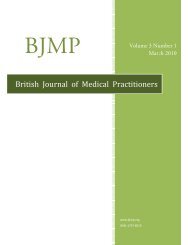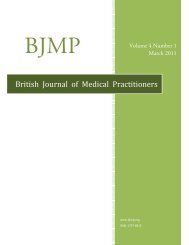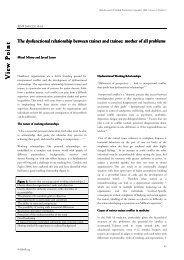R esearch A rticle - British Journal of Medical Practitioners
R esearch A rticle - British Journal of Medical Practitioners
R esearch A rticle - British Journal of Medical Practitioners
Create successful ePaper yourself
Turn your PDF publications into a flip-book with our unique Google optimized e-Paper software.
<strong>British</strong> <strong>Journal</strong> <strong>of</strong> <strong>Medical</strong> <strong>Practitioners</strong>, March 2013, Volume 6, Number 1<br />
problem. These characteristics are especially important when<br />
managing chronic disorders, such as IBS, where there is a high<br />
priority on continuity <strong>of</strong> care 6 .<br />
There is currently no biochemical, histopathological or<br />
radiological diagnostic test for IBS. The diagnosis is based<br />
principally on symptom assessment. The Rome III criteria<br />
(Figure 1) is the most recent, updated and universal diagnostic<br />
criteria for IBS. However, although the Rome III criteria are<br />
widely used in clinical studies, it is not used by most<br />
cliniciansIn fact, most primary care physicians are not aware <strong>of</strong><br />
diagnostic criteria for IBS and about one third <strong>of</strong> secondary care<br />
doctors do not use them in practice 6 .<br />
IBS patients are grouped on the basis <strong>of</strong> the most predominant<br />
bowel symptom as diarrhoea- predominant, constipationpredominant,<br />
a mixture <strong>of</strong> both diarrhoea and constipation,<br />
and un-subtyped IBS in patients with an insufficient<br />
abnormality <strong>of</strong> stool consistency to meet the criteria for the<br />
other sub-groups. Approximately one third <strong>of</strong> patients have<br />
diarrhoea- predominant, one third have constipationpredominant,<br />
and the remainder have a mixture <strong>of</strong> both<br />
diarrhoea and constipation. The classification <strong>of</strong> IBS patients<br />
into sub-groups is useful for clinical practice, but it is common<br />
for IBS patients to switch from one subtype to another over<br />
time. More than 75% <strong>of</strong> IBS patients change to either <strong>of</strong> the<br />
other 2 subtypes at least once over a 1-year period 2,10 .<br />
Figure 1 - Rome III diagnostic criteria* for IBS 6<br />
Recurrent abdominal pain or discomfort** at least 3 days a month in<br />
the past 3 months, associated with two or more <strong>of</strong> the following:<br />
• Improvement with defecation<br />
• Onset associated with a change in frequency <strong>of</strong> stool<br />
• Onset associated with a change in form (appearance) <strong>of</strong> stool<br />
*Criteria fulfilled for the past 3 months with symptom onset at least 6<br />
months before diagnosis<br />
** “discomfort” means an uncomfortable sensation not described as<br />
pain<br />
According to the National Institute for Health and Clinical<br />
Excellence (NICE), healthcare pr<strong>of</strong>essionals should consider<br />
assessment for IBS if a patient presents with any <strong>of</strong> the<br />
following symptoms for at least six months 11 :<br />
• abdominal pain/discomfort<br />
• bloating<br />
• or a change in bowel habit<br />
NICE has also given the following guideline pertaining to “red<br />
flag” indicators. All people presenting with possible IBS<br />
symptoms should be asked if they have any <strong>of</strong> the following<br />
indicators. Referral to secondary care should be made if any are<br />
present 11 :<br />
• unintentional and unexplained weight loss<br />
• rectal bleeding<br />
• family history <strong>of</strong> bowel or ovarian cancer<br />
• change in bowel habit to looser and/or more frequent stools<br />
persisting for more than 6 weeks in a person aged over 60<br />
years.<br />
Furthermore, all patients presenting with IBS symptoms should<br />
be appropriately assessed and clinically examined for the<br />
following 'red flag' indicators. A referral should be made to<br />
secondary care if any are present 11 :<br />
• Anaemia<br />
• Abdominal masses<br />
• Rectal masses<br />
• Inflammatory markers for inflammatory bowel disease<br />
• Serum CA125 should be measured in women with<br />
symptoms that suggest ovarian cancer<br />
In addition, NICE have stated that IBS should be considered<br />
only if the person has abdominal pain or discomfort that is<br />
either relieved by defecation or associated with altered bowel<br />
frequency or stool form. This should be accompanied by at least<br />
two <strong>of</strong> the following four symptoms 11 :<br />
• altered stool passage (straining, urgency, incomplete<br />
evacuation)<br />
• abdominal bloating (more common in women), distension,<br />
tension or hardness<br />
• symptoms made worse by eating<br />
• passage <strong>of</strong> mucus<br />
Other features such as lethargy, nausea, backache and bladder<br />
symptoms are common in people with IBS, and may be used to<br />
support the diagnosis.<br />
According to NICE, patients who meet the IBS diagnostic<br />
criteria should have the following tests to exclude other<br />
diagnoses (Figure 2):<br />
Figure 2 11 - Tests to exclude other diagnoses<br />
Full blood count (FBC)<br />
Erythrocyte sedimentation rate (ESR) or plasma viscosity<br />
C-reactive protein (CRP)<br />
Antibody testing for coeliac disease (endomysial antibodies [EMA] or<br />
tissue transglutaminase [TTG])<br />
The value <strong>of</strong> serological tests for coeliac disease (EMA or TTG<br />
antibodies) in patients with IBS diarrhoea-predominant<br />
depends on the population and is generally considered costeffective<br />
if the incidence <strong>of</strong> coeliac disease is above 1%. It is<br />
therefore likely to be beneficial in the United Kingdom, where<br />
up to 3% <strong>of</strong> cases <strong>of</strong> IBS diarrhoea-predominant in primary<br />
care have coeliac disease 6 .<br />
The following tests are not necessary to confirm diagnosis in<br />
people who meet the IBS diagnostic criteria 11 :<br />
• Ultrasound<br />
• Rigid/flexible sigmoidoscopy<br />
BJMP.org<br />
35







